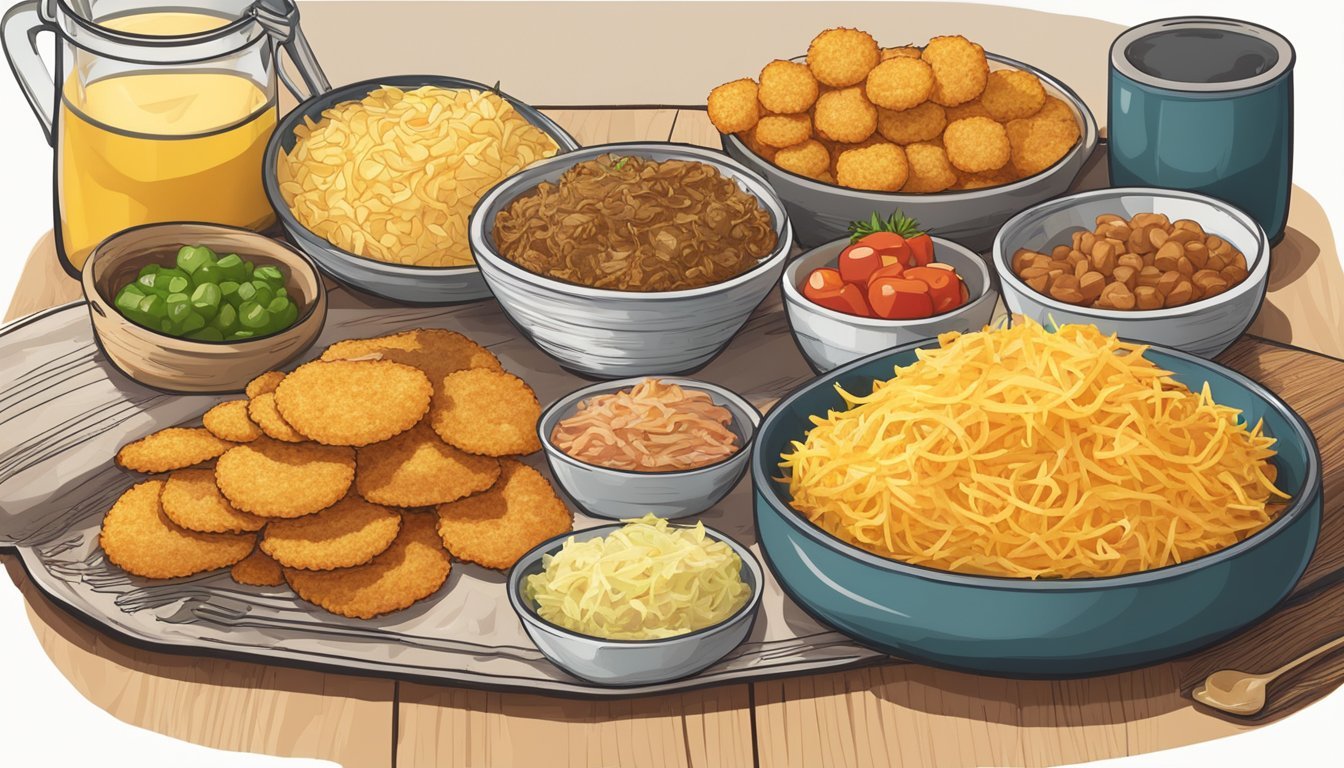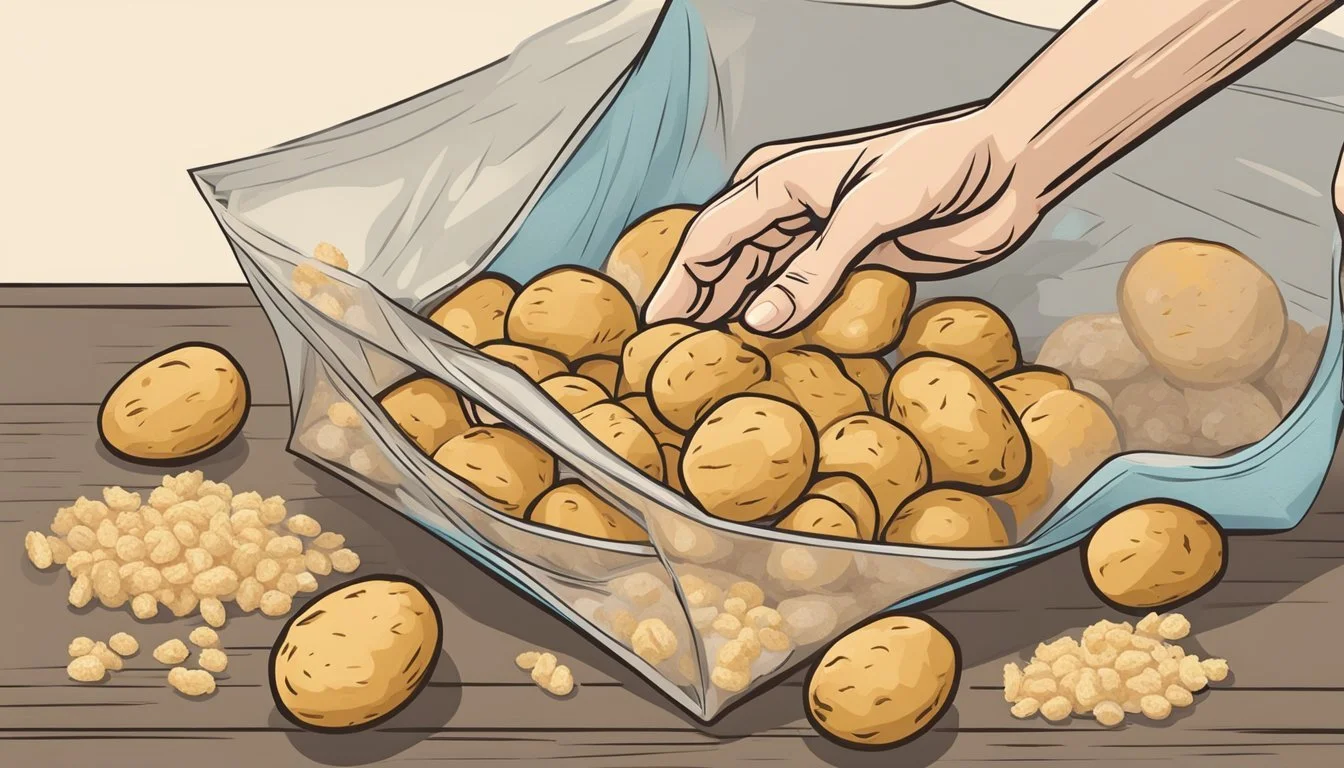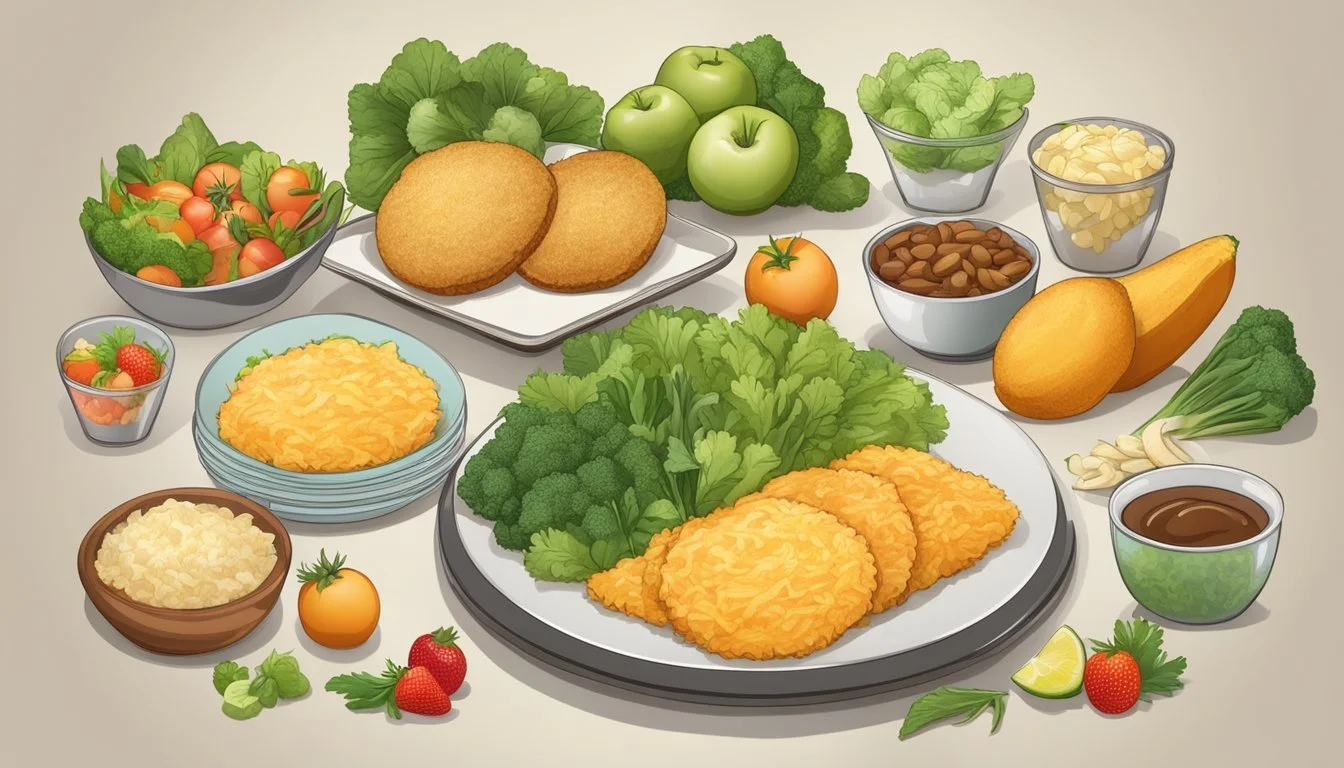Fresh vs Frozen Hash Browns: A Comparison of Taste, Texture, and Convenience
Hash browns are a beloved breakfast staple and versatile side dish enjoyed by many. These crispy potato delights can be made from either fresh or frozen potatoes, each offering unique qualities to the final product. Fresh potatoes provide more control over flavor and texture, while frozen hash browns offer convenience and consistency.
The choice between fresh and frozen hash browns often comes down to personal preference and time constraints. Fresh potatoes require more preparation, including peeling, shredding, and sometimes soaking to remove excess starch. Frozen hash browns, on the other hand, come pre-shredded and ready to cook, making them a time-saving option for busy mornings.
Both varieties can yield delicious results when prepared properly. Fresh hash browns tend to have a more pronounced potato flavor and can be customized with additional ingredients like onions or spices. Frozen hash browns, while containing minimal additives, offer reliable texture and browning due to added ingredients like dextrose. Whether using fresh or frozen, the key to perfect hash browns lies in achieving that golden-brown exterior and tender interior that potato lovers crave.
Understanding Hash Browns
Hash browns are a beloved breakfast staple made from shredded potatoes. These crispy, golden-brown patties or loose piles of potato goodness have become a fixture on breakfast menus and in home kitchens across America.
History and Popularity
Hash browns emerged in the United States in the 1890s. The term "hashed brown potatoes" first appeared in cookbooks around this time. Initially, they were made from leftover boiled potatoes, chopped and fried until crispy.
As their popularity grew, restaurants began preparing hash browns from raw potatoes. The dish gained widespread appeal in the 1950s when diners and fast-food chains added them to their menus. Today, hash browns are a breakfast staple in many countries.
Their versatility and simple preparation have contributed to their enduring popularity. Hash browns can be easily customized with various ingredients and seasonings, making them a favorite for both home cooks and professional chefs.
Basic Ingredients and Variations
The core ingredients of hash browns are simple: potatoes, oil, salt, and pepper. Shredded potatoes form the base, while oil helps achieve the desired crispy texture. Salt and pepper provide basic seasoning.
Common variations include:
Adding diced onions for extra flavor
Incorporating cheese for a richer taste
Using egg as a binding agent for firmer patties
Some recipes call for additional spices or herbs to enhance flavor. Paprika, garlic powder, or fresh chives are popular choices.
Hash browns can be prepared in different shapes and sizes:
Loose, scattered style
Formed into patties
Pressed into a large cake (sometimes called a rösti)
The cooking method also varies, with options including pan-frying, deep-frying, or baking. Each technique produces a slightly different texture and flavor profile.
Comparison of Fresh and Frozen Hash Browns
Fresh and frozen hash browns differ in texture, flavor, nutrition, and preparation methods. These differences impact the final dish and cooking experience.
Texture and Flavor Differences
Fresh hash browns typically offer a crispier exterior and fluffier interior when cooked properly. They tend to have a more pronounced potato flavor and can achieve a golden-brown color more easily.
Frozen hash browns often have a more uniform texture throughout. They may not crisp up as readily as fresh ones, but they can still achieve a satisfying crunch when fried correctly.
Fresh potatoes retain more natural moisture, which can lead to a creamier interior. Frozen varieties sometimes have added ingredients like dextrose to aid browning.
Health and Nutrition
Fresh potatoes generally contain higher levels of vitamin C and potassium compared to their frozen counterparts. The freezing process can cause some nutrient loss, particularly in vitamin C content.
Frozen hash browns often have minimal additives, usually limited to preservatives for color retention. They can be a convenient option without significant nutritional drawbacks.
Both fresh and frozen hash browns are typically low in cholesterol. The calorie content is similar, but can vary based on preparation methods and added fats during cooking.
Fresh potatoes offer more control over sodium levels, as some frozen varieties may contain added salt. Overall, both options can be part of a balanced diet when prepared with health in mind.
Preparation Techniques
Proper preparation is key to achieving delicious hash browns, whether using fresh or frozen potatoes. The right techniques can elevate this simple dish to crispy perfection.
From Scratch: Peeling and Shredding
To make hash browns from scratch, start with russet potatoes. Peel the potatoes thoroughly, removing all skin and eyes. Shred them using a box grater or food processor with a grating attachment.
Rinse the shredded potatoes in cold water to remove excess starch. This step is crucial for achieving a better texture. Drain thoroughly and pat dry with paper towels or a clean kitchen cloth.
To prevent discoloration, work quickly or submerge shredded potatoes in cold water until ready to cook. Squeeze out as much moisture as possible before cooking. This reduces water content, leading to crispier hash browns.
Cooking Methods
Hash browns can be cooked using various methods, each producing different results.
Stovetop: Heat oil or butter in a skillet over medium-high heat. Spread the potatoes evenly and cook until golden brown, flipping once.
Oven: Preheat to 425°F. Spread potatoes on a baking sheet, drizzle with oil, and bake until crispy, turning halfway through.
Air fryer: Cook at 400°F for 8-10 minutes, flipping halfway.
Griddle: Preheat to 400-425°F. Add butter and oil to the surface before cooking the hash browns.
Achieving the Perfect Crispness
For optimal crispiness, use a generous amount of oil or butter. This helps create a golden-brown exterior. Avoid overcrowding the pan, as this can lead to steaming instead of frying.
Press the potatoes down with a spatula to increase surface contact with the pan. This promotes even browning and crispiness.
Season with salt and pepper during cooking to enhance flavor. For extra crunch, mix in a small amount of flour or cornstarch before cooking.
Allow the hash browns to cook undisturbed for several minutes before flipping. This helps form a crispy crust. Flip only once to maintain structural integrity and ensure even cooking.
Serving and Pairing Ideas
Hash browns are versatile and can be served in various ways. They pair well with many breakfast staples and can be customized with different toppings and accompaniments.
Hash Browns as a Side
Hash browns make an excellent side dish for classic American breakfasts. They complement scrambled, fried, or poached eggs perfectly. The crispy texture of hash browns contrasts nicely with fluffy eggs.
For a heartier meal, serve hash browns alongside crispy bacon or juicy sausage links. The savory flavors of these meats enhance the potato's taste.
Hash brown patties can also be used as a base for breakfast sandwiches. Top them with a fried egg and cheese for a quick, portable meal.
Accompaniments and Toppings
Ketchup is a popular condiment for hash browns, adding a tangy sweetness. For cheese lovers, sprinkle shredded cheddar or American cheese on top while the hash browns are still hot.
Diced onions and bell peppers can be mixed into the hash browns before cooking for added flavor and nutrition. Sautéed mushrooms also make a delicious topping.
For a spicy kick, try topping hash browns with salsa or hot sauce. Sour cream or Greek yogurt can balance out the heat and add creaminess.
Guacamole is another great option, bringing a creamy texture and zesty flavor that complements the crispy potatoes well.
Storage and Freezing Tips
Proper storage and freezing techniques are essential for maintaining the quality and texture of hash browns. Moisture control and packaging play key roles in preserving these potato products for extended periods.
Proper Freezing Techniques
To freeze hash browns effectively, start by shredding clean potatoes using a food processor. Rinse the shreds in cold water until the liquid runs clear to remove excess starch. Pat dry thoroughly with paper towels or a clean kitchen cloth to eliminate moisture.
Spread the potato shreds in a single layer on a baking sheet lined with parchment paper. Flash freeze for 1-2 hours until solid. Transfer the frozen shreds to airtight freezer bags or containers, removing as much air as possible to prevent freezer burn.
Label containers with the date and use within 2-3 months for best quality. For convenience, portion hash browns into meal-sized amounts before freezing.
Reheating for Best Quality
To reheat frozen hash browns, avoid thawing them first as this can lead to excess moisture and mushy texture. Cook directly from frozen for optimal results.
Skillet method: Heat oil in a pan over medium-high heat. Add frozen hash browns in a thin layer and cook for 4-5 minutes per side until golden and crispy.
Oven method: Preheat to 425°F (220°C). Spread hash browns on a baking sheet, drizzle with oil, and bake for 15-20 minutes, flipping halfway through.
Air fryer: Cook at 370°F (188°C) for about 15 minutes, shaking the basket occasionally.
For frozen hash brown patties, follow package instructions but add a few extra minutes to ensure a crispy exterior.
Choosing the Right Potato
Selecting the ideal potato variety is crucial for achieving perfect hash browns. The type of potato impacts texture, flavor, and overall cooking results.
Varieties and Their Qualities
Russet potatoes are a top choice for hash browns due to their high starch content. They produce crispy exteriors and fluffy interiors when cooked. Yukon Gold potatoes offer a buttery flavor and golden color, making them another excellent option.
Red potatoes have a waxy texture and hold their shape well, resulting in firmer hash browns. For a unique twist, sweet potatoes can be used to create colorful and slightly sweet hash browns.
Fingerling potatoes, while less common, can provide interesting textures and flavors in hash brown dishes. Their smaller size requires more careful shredding.
Impact on Texture and Flavor
Starch content significantly affects hash brown texture. High-starch potatoes like russets create crispier edges but may become gummy if overworked. Low-starch varieties maintain their shape better but don't crisp as easily.
Flavor variations between potato types are subtle but noticeable. Russets have a neutral taste that pairs well with various seasonings. Yukon Golds impart a naturally buttery flavor.
Skin-on hash browns retain more nutrients and add visual appeal. However, peeled potatoes often result in a more uniform texture and appearance.
Freshly shredded raw potatoes release more moisture, requiring extra steps to remove excess water for optimal crispiness. This process can enhance the natural potato flavor in the final dish.
Advanced Tips and Techniques
Mastering hash browns requires attention to detail and specialized techniques. Professional chefs employ specific tools and methods to achieve perfect texture and flavor.
Professional Tools and Approaches
Restaurants often use a food processor to shred potatoes quickly and uniformly. This ensures consistent cooking and crispy results. A box grater works well for smaller batches at home. Some chefs prefer a Blackstone griddle for large-scale cooking, as it provides even heat distribution.
For optimal crispiness, cook hash browns in a single layer. This allows each piece to brown properly. Professional kitchens use high-heat flat-top grills to achieve a golden crust.
Many chefs par-cook potatoes before shredding. This reduces moisture and speeds up the final cooking process. Some restaurants pre-season their potatoes, allowing flavors to develop before cooking.
Avoiding Common Mistakes
Excess moisture is the enemy of crispy hash browns. After shredding, squeeze potatoes thoroughly in a clean kitchen towel. Let them rest to release more water, then squeeze again.
Avoid overcrowding the pan. This traps steam and leads to mushy hash browns. Cook in batches if necessary.
Resist the urge to flip too early. Allow a golden crust to form before turning. This typically takes 3-5 minutes per side.
Watch heat levels carefully. Too high, and hash browns burn before cooking through. Too low, and they become greasy. Medium-high heat usually works best.
For frozen hash browns, thaw completely before cooking. This ensures even heating and prevents a raw center.
Commercial and Brand Variations
Grocery stores offer an array of frozen hash brown options, from shredded potatoes to pre-formed patties. Major brands and store labels compete for market share, with varying ingredients and processing methods.
Store-Bought Options
Ore-Ida, a well-known name in frozen potatoes, produces shredded hash browns that are widely available. Their 30-ounce bags provide a convenient option for home cooks. Other popular brands include Hill Country Fare and Giant, which offer both shredded and patty-style hash browns.
McDonald's hash browns have set a high standard for taste and texture in the fast-food industry. Many store-bought brands aim to replicate this crispy exterior and soft interior.
Prices vary significantly between brands. Some offer better value, while others focus on premium quality or organic ingredients.
Examining Additives and Preservatives
Most commercial frozen hash browns contain additives to maintain quality and extend shelf life. Dextrose, a form of sugar, is commonly added to enhance browning and flavor.
Sodium acid pyrophosphate is frequently used to prevent discoloration in frozen potatoes. This preservative helps maintain the appealing golden color consumers expect.
Some brands prioritize minimal processing and fewer additives. These options may have shorter shelf lives but appeal to health-conscious consumers.
Reading ingredient labels is crucial for those with dietary restrictions or preferences. Organic and additive-free options are becoming more prevalent in response to consumer demand.
Nutritional Information and Health Benefits
Hash browns offer a mix of macronutrients and some micronutrients, though their health impact varies depending on preparation method and ingredients used.
Caloric and Macro Content
Fresh and frozen hash browns typically contain 140-180 calories per 100-gram serving. The majority of these calories come from carbohydrates, with 15-20 grams per serving. Fat content ranges from 5-10 grams, depending on cooking methods. Hash browns provide 1-3 grams of protein per serving.
Sodium levels can be high, especially in pre-packaged or restaurant versions, sometimes reaching 500-1000mg per serving. This accounts for a significant portion of the recommended daily intake.
Vitamins, Minerals, and Other Nutrients
Hash browns contain small amounts of essential nutrients. Potassium is present, with about 300-400mg per serving. Vitamin C content is minimal, as most is lost during cooking.
Iron and B vitamins are found in trace amounts. Leaving the potato skin on can increase fiber and nutrient content slightly. Sweet potato hash browns offer more vitamin A and slightly higher fiber.
Restaurant or frozen varieties may have added preservatives or oils that impact nutritional value. Homemade versions allow for better control over ingredients and cooking methods, potentially making them a healthier option.







